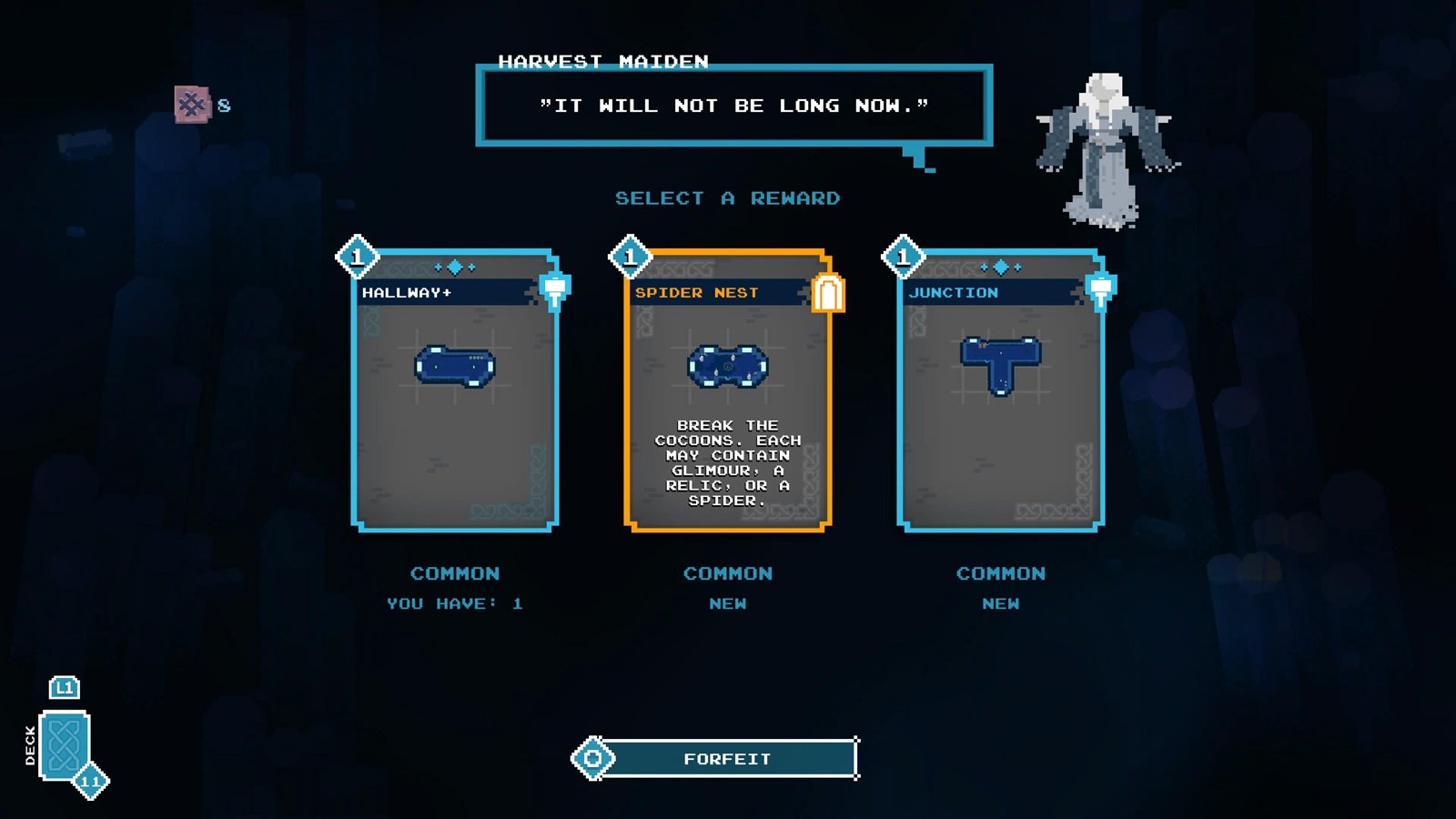Into The Restless Ruins on PS5
Over the past decade or so, roguelikes have grown into one of the most popular genres of games in the Indie space. From Slay the Spire to Hades, roguelikes have garnered critical acclaim, but due to their popularity, some may argue that the genre has become a bit stale. Ant Workshop and Wales Interactive‘s Into the Restless Ruins seeks to change that.
Into the Restless Ruins isn’t just as straight-up rougelike. Not only does it mix traditional roguelike gameplay with Vampire Survivor‘s autobattling nature, but it even adds deckbuilding mechanics to help differentiate it from its competition. It’s a weird mix of genres to be sure, one that I began to grapple with when I first began playing, but after a certain point, it clicked with me, and that’s when I felt the game truly opened up for me. And just as soon as it clicked with me, it ended.
After a brief tutorial that introduces you to the basic, and I do mean basic, gist of how the game’s gameplay loop goes, you’ll be free to begin making runs into the six different ruins available. No matter which set of ruins you decide to explore, the core gameplay loop remains the same.
First, you begin with the deck-building portion, where you draw five cards, each representing a different room. In Into the Restless Ruins, you are constructing the dungeons that you’re adventuring in. It’s like an inverse Dungeon Keeper since, technically, you can make the dungeon as straightforward or as complex as you want.
If you want to design a dungeon that’s just one long hallway, you can do so. If you want to create a complicated dungeon filled with plenty of side rooms, you’re allowed to, since most rooms, when placed, provide some passive boost or grant you access to new weapons, health boosts, and most importantly, flames for your torch.
You can only place as many rooms as you have Build Points, or BP, but you can easily increase your total depending on how you design your dungeon. Of course, you’re also limited in how you can connect the various rooms (you can’t build on top of pre-established rooms, and all rooms must connect), but you’re free to construct your dungeon as you see fit.

Some ruins will have an inherent gimmick behind them that will encourage how you construct your level. For example, in the third level, Jarlshof, while the Warden is to the far left, several of the seals are to the far right and you’ll need to break them if you want to reach the Warden, meaning you’ll have to build two mini dungeons, one going east and the other west, to utilize your time effectively.
Another level, Dunvegan, places the Warden in the centre of the map, but you’ll need to construct a large ring around them in order to reach the different seals. I loved how the game subtly encouraged you to think outside of the box when designing your dungeon, but with only six levels to choose from, there aren’t too many opportunities for Into the Restless Ruins to evolve its concept.
In fact, that’s probably the biggest criticism I have about the game. Given that there are only six levels, and one of them is a very basic tutorial, the game seems pretty lacking in content. Once you conquer each set of ruins, there’s little reason to go back there other than to grind up levels.

Granted, like most roguelikes, you’re able to add modifiers – here known as cantrips – that can make runs significantly more challenging or make dungeon crawling a breeze. The more negative cantrips you have equipped, the more experience points you’ll earn after finishing a run. That may sound like a good incentive, but there’s little levelling up actually does for you.
Each time you level up, a few new cards will be added to the pool of selectable cards you can earn during each run, and a few new cantrips will be unlocked, but there’s no guarantee you’ll use any of them. Some cards can be so niche you won’t ever use them, like a card that creates a room that can boost your luck, a stat that I never once bothered with during my dungeon runs. Cantrips can increase the amount of experience points earned, but when there is no real benefit to levelling up, why would I want to equip them? It would be one thing if your base stats levelled up, which would make returning to earlier dungeons somewhat more interesting and make later dungeons more fair, but they don’t.
At the very least, the core gameplay loop of designing a dungeon and then autobattling through it is rock solid. I liked setting my own goals each time I entered a dungeon for a night. Should I try to make my way to a fog-filled room and see if it has a seal, or should I just visit an NPC to level up my rooms and increase their benefits? Or should I just kill enemies so that I can receive a blessing from the Harvest Maiden and earn a new card for my deck? Not only that, all of those decisions are contingent on the amount of light left in your torch, which steadily burns throughout the night, limiting your visibility and making navigating back towards the entrance all the more difficult as the night progresses.

The moment-to-moment decisions of Into the Restless Ruins were fun and made me eager to jump into another night, but as time went on, I realised that a lot of your progress was limited somewhat by RNG. If you draw a bad hand, then there wasn’t much you could do about it outside of discarding a card and redrawing. I never felt like I wasted a night when this happened, since you could also just grind for more cards via blessings, but it did make me feel like I was spinning my wheels and waiting for the one card I needed.
When you do receive a blessing, there is always the risk that the three cards presented to you would be worthless ones. The odds of you getting the one card you need were low, and the higher your level, the greater the chance that you would get a card that was worthless to you, since you would have unlocked so many cards by that point. I did find that this did lead me to some experimentation, like when I realized I can fill my deck with Jails, which when placed together can boost your strength to a ludicrous degree, but Occam’s Razor was usually in effect here – if the plan I already had to craft my dungeon was effective, why would I experiment with other methods that may not be as effective?
By the time I defeated the final Warden, I couldn’t help but feel deflated. The last Ruin was hard, especially when you realise just how large it is, but once it was over, that was it. There was no fanfare or congratulations, just a textbox that basically said to keep doing more runs. There was a hint of something more, but given that I would just be grinding the same levels again for the vague notion of a true ending, I didn’t see any reason to keep going. By that point, I felt like I had seen everything that Into the Restless Ruins had to offer.
When Into the Restless Ruins is at its best, it’s an addictive experience. I was playing the game nonstop. The autobattling and dungeon-building were great overall, but the ways that certain dungeons were designed elevated it. The presentation and soundtrack for the game were solid throughout, especially the tunes that play during the deckbuilding portion, but after a while, you’ll reach a point with Into the Restless Ruins when you’ve seen everything it has to offer. Whether or not you want to continue beyond that is up to you, but for many, you’ll probably be satisfied with conquering each dungeon once and then moving on to greener pastures.

A roguelike is defined by its replayability, and the fact that I had little desire to keep doing runs is indicative that Into the Restless Ruins doesn’t have enough content to sustain itself. Maybe with some more updates and DLC, it will, but as it stands, this is a good beginner-friendly roguelike that needs a bit more meat on its bones to become something great.
Into the Restless Ruins is available on PlayStation 5, Xbox Series X|S, Nintendo Switch, and PC.
SavePoint Score
Summary
While it features a compelling gameplay loop that combines deckbuilding and auto-battling, Into the Restless Ruins feels threadbare in its content and lacks sufficient incentives for players to continue playing.

